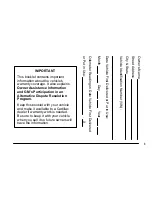
© Copyright Mahindra and Mahindra Ltd. 062016
10-3
Tire Pressure Placard
SYSTEMS
ENGINE
MAXIMILE Feo
MAXIMILE Elite
MAXIMILE Syntec F2
MAXIMILE ULTRACOOL
CASTROL/SHELL DOT 4
SHELL SPIRAX S3 ATF MD3
AXLE
TRANSMISSION
BRAKE/CLUTCH
POWER STRG
ENG COOLANT
RECOMMENDED OIL
THAR m2DiCR
R
E
A
R
F
R
O
N
T
TYRE PRESSURE Kg/cm
2
(psi)
UNLADEN
TYRE SIZE
235/70 R16
TUBELESS
2.4(34)
2.4(34)
2.4(34)
2.4(34)
LADEN
U52M03
TIRE INFLATION PRESSURE kg/cm
2
(Psi)
Front
2.0 kg/cm
2
(28 Psi)
Rear
2.2 kg/cm
2
(32 Psi)
Tire Label (Vehicle Placard) tells you important information about
tire size designed for your vehicle, and the laden/unladen tire
inflation pressures for the front & rear tires. The label is pasted
above the driver door trim.
Never overload your vehicle. Overloading can cause tire failure,
affect vehicle handling, and increase your stopping distance,
resulting in an accident and/or personal injury.
Improper inflated tires can adversely affect vehicle handling or
can fail unexpectedly, resulting in an accident and/or personal
injury.
Under-inflation is the most common cause of tire failures and
may result in severe tire cracking, tread separation or
“blowout”, with unexpected loss of vehicle control and increased
risk of injury. Under-inflation increases sidewall flexing and
rolling resistance, resulting in heat buildup and internal damage
to the tire.
Check and set tire pressure at ambient temperature before
starting to drive the vehicle or 15 - 20 minutes after a drive.
The tyres fitted in the vehicle meet the requirements of BIS and
they would comply with the requirements under the CMVR
1989, as mentioned Notification SO 2953E.
The service life of a tire is dependent upon various factors including
but not limited to;
•
Driving style
•
Tire pressure
•
Distance driven
Do not use a tire, wheel size or speed rating other than that
specified for your vehicle on the tire placard. Combinations of
WHEELS AND TIRES
















































